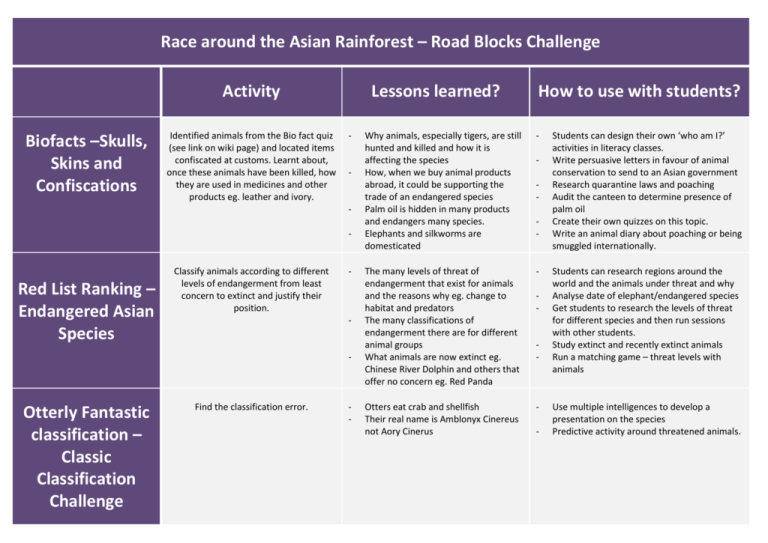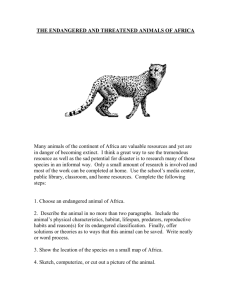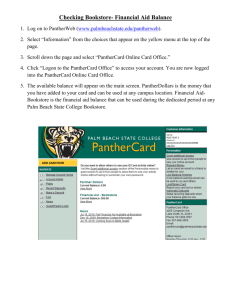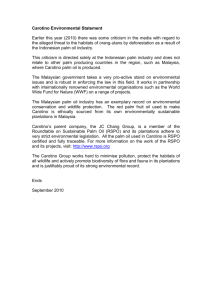Race_Around_the_Asian_Rainforest_2012
advertisement

Race around the Asian Rainforest – Road Blocks Challenge Activity Biofacts –Skulls, Skins and Confiscations Identified animals from the Bio fact quiz (see link on wiki page) and located items confiscated at customs. Learnt about, once these animals have been killed, how they are used in medicines and other products eg. leather and ivory. Lessons learned? - - - Red List Ranking – Endangered Asian Species Classify animals according to different levels of endangerment from least concern to extinct and justify their position. - - - Otterly Fantastic classification – Classic Classification Challenge Find the classification error. - How to use with students? Why animals, especially tigers, are still hunted and killed and how it is affecting the species How, when we buy animal products abroad, it could be supporting the trade of an endangered species Palm oil is hidden in many products and endangers many species. Elephants and silkworms are domesticated - The many levels of threat of endangerment that exist for animals and the reasons why eg. change to habitat and predators The many classifications of endangerment there are for different animal groups What animals are now extinct eg. Chinese River Dolphin and others that offer no concern eg. Red Panda - Otters eat crab and shellfish Their real name is Amblonyx Cinereus not Aory Cinerus - - - - - Students can design their own ‘who am I?’ activities in literacy classes. Write persuasive letters in favour of animal conservation to send to an Asian government Research quarantine laws and poaching Audit the canteen to determine presence of palm oil Create their own quizzes on this topic. Write an animal diary about poaching or being smuggled internationally. Students can research regions around the world and the animals under threat and why Analyse date of elephant/endangered species Get students to research the levels of threat for different species and then run sessions with other students. Study extinct and recently extinct animals Run a matching game – threat levels with animals Use multiple intelligences to develop a presentation on the species Predictive activity around threatened animals. Tree of Life – biodiversity in the Indonesian Rainforest Use flashcards to determine how many animal or plant species are supported by one large tree in the Rainforest and watch a DVD on the environmental effects of the production of Palm Oil. - - - The biodiversity of a tree habitat and how it can support a large amount of big and small species eg. orang-utans and up to 150 different kinds of butterfly How interlinked the habitat of the Rainforest is and how the elimination of one tree can have a huge effect Awareness of the negative effect the production of Palm Oil has on the environment and how it is labelled on food packaging eg. as vegetable oil - - - - Signs of Life – Asian biodiversity Challenge Food for Thought – Web of Life Use coloured blocks to create an environmental jenga tower and simulate a balanced ecosystem factoring in external influences such as pollution and climate change. Create food chains using picture cards of animals and insects. - - - - How fragile an ecosystem is and how easily it can be damaged The acronym CHIPPS which represents elements that create change in an ecosystem: C – Climate Change H – Habitat destruction I – Introduction of new species P – Pollution P – Poaching S – Solutions - That animals and insects can adapt their food needs according to their surroundings if needed How dependant animals and insects are on each other within a food chain; the importance of reproduction on the food chain; if one is removed (especially top order predators) it puts their ecosystem out of balance The negative effects human destruction of a habitat has on food chains - - - - - Investigate what foods can contain Palm Oil and try to cook it with a substitute product in home economics class eg. bread Investigate and compare different tree species and their role in the ecosystem. Students can collect bark, leaves and flowers as an interactive activity Use in English classes as a persuasive writing task. Students can write letters to local politicians and food companies asking what they are doing to achieve mandatory labelling. Information at www.zoo.org.au/palmoil Field trip to a supermarket for Palm oil products Audit canteen and graph results of palm oil Replicate the game in class which can spark discussion on the negatives that affect the environment and how it needs balance to survive. Provides team work, co-operation, a futures orientation approach and problem solving in relation to variables. Awareness project on why students need to be more eco-friendly and ideas on how they can apply this to their everyday life Research where waste ends up Game can be used in both geography and science class to study different animals and ecosystems. Students can discuss the impact of removing an animal or insect and justify their position in a chain Students can also create their own examples of food chains and represent as a hanging mobile. Predator/prey tiggy Use as part of the introductory and assessment understandings. People, Poo and Progress – Animal/Human Conflict Make cards and bookmarks using recycled paper from Sri Lanka. The paper is made from 80% elephant dung and 20% rice paddy stubble. - - - - There is a Bill before Parlimanet to make mandatory the labelling of Palm Oil products. The conflict between animals and humans due to us destroying the forests they live in The importance of recycling so to preserve forests for animals like orangutans and elephants The recycle potential of many different waste products to make things such as paper - - - Students can learn about recycling paper and make some themselves Replicate the game in art class so to practice being environmentally friendly and build awareness of recycling Research project on different ways to recycle and how the school and students family can improve their recycling methods Visit www.saynotopalmoil.com Use social media to raise awareness of palm oil or write to companies asking them to stop using palm oil (persuasive writing)





